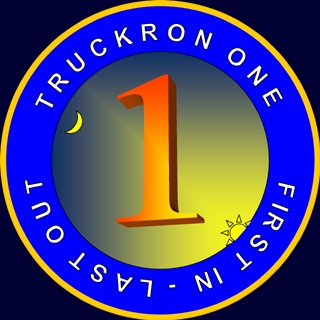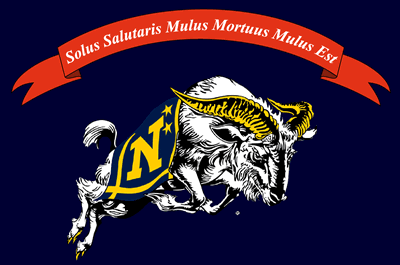USS BEATARMY
A Good Name, A Good Ship
|
|
|
USS BEATARMY (HUA 90) is the name given to the Navy's premier Heavy Urban Assault vehicle. These vehicles are designed to provide close combat support for naval forces on urban fields of conflict. The urban assault vehicle concept was developed in late 1991. With the end of the Cold War and the demise of the Soviet Union, the Navy recognized a need to shift its focus from blue water to littoral and inland operations. The Navy announced this shift in its 1992 policy memo "Forward....From the Sea", in which the Navy promulgated its vision of a 21st Century fleet emphasizing amphibious assault capability, land attack, and inland power projection. This concept of land attack took its most literal (and most bizarre) form with the urban assault vehicle. To date, seven vehicles have carried the name BEATARMY; a brief history of each is provided below. USS BEATARMY's crest features the famous "Bill the Goat" (azure, a goat rampant) along with the ship's motto, "Solus Salutaris Mulus Mortuus Mulus Est" ("The only good mule is a dead mule"). USS BEATARMY's decorations include the Navy Unit Commendation, the Meritorious Unit Commendation, 3 Battle 'E's (one for each victory over Army in 1997, 1999, and 2000), the National Defense Medal, the Southwest New Jersey Deployment Ribbon (with 4 stars), and the Sea Service Deployment Ribbon (with 7 stars). |

1992In response to the Navy's request, the Bush administration included funding in the 1992 defense budget for the design and construction of a Light Urban Assault vehicle (LUA), conceived as a fast attack, all-weather urban superiority vehicle. The result was the first USS BEATARMY, which made her operational debut on 5 December during the Navy's 1992 Tailgate Exercises (TAILGATEX 92) in Philadelphia. Dressed in the "recreational vehicle" camouflage which would become her trademark, the scrappy little vessel performed better than her designers anticipated; unfortunately, however, the day's battle ultimately ended in defeat for Navy. The designers of the LUA attributed the loss to the vehicle's being undersized for her mission, and hence began developing plans for a larger vessel on the theory that "bigger is better". Commanding
Officer: Andrew D. Bush * * * * * * * * * |
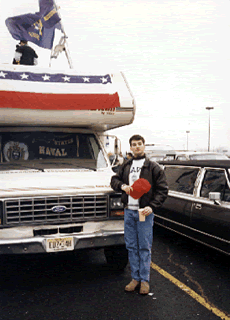
1993After a promising start, the urban assault vehicle program took a step backward in 1993. Deep budget cuts inflicted by the newly-elected Clinton administration left the Navy without SCN funding for the larger vehicle they had envisioned. Unwilling to abandon the program altogether, the Navy instead decided to prove their "bigger is better" theory by converting a retired Vietnam-era troop carrier into a Medium Urban Assault craft (MUA). The unfortunate result was the second BEATARMY, a vehicle that by all accounts was best described as a "mechanical a******". The conversion work, performed by a small repair yard in Hoboken, New Jersey, was rushed and incomplete; a resulting steering gear casualty made this the only urban assault vehicle to ever be involved in a collision. Several historians suggest that this vessel was responsible for Navy kicker Ryan Bucchianeri's potentially game-winning kick sailing wide right, but this has never been proven. Commanding
Officer: William F. Nugent * * * * * * * * * |

1996-1997The 1993 MUA fiasco taught the Navy the valuable lesson of proper planning. Plans to introduce a newer, larger vessel for 1994 were therefore postponed, and in fact it was not until 1996 that the Heavy Urban Assault vehicle (HUA) was introduced. The delay proved to be well advised: The third BEATARMY was bigger, faster, and far more capable than her predecessors and well exceeded the Navy's performance expectations. This vessel, known as "The Gray Ghost of the Jersey Coast", saw battle both in Philadelphia and East Rutherford -- the only urban assault vehicle to date to serve in two different conflicts, including a decisive 39-7 victory over Army in 1997. Commanding Officer: Timothy S. Bush Final
Score: * * * * * * * * * |
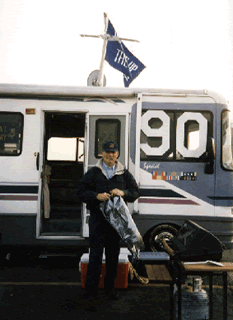
1998The fourth BEATARMY was a larger refinement of her immediate predecessor. Built by the Abel yard in Martinsburg, West Virginia, this vessel was commissioned in Philadelphia on 4 December 1998, in a dual ceremony with the AEGIS guided missile destroyer USS Donald Cook (DDG 75). The vehicle went on to a distinguished career, serving as the flagship of RADM Bill Cobb during the closely fought battle on 5 December. Commanding
Officer: Lee A. Fuglestad * * * * * * * * * |

1999The 1999 deployment of BEATARMY had an ominous beginning which nearly doomed the entire campaign. Based on the success of the previous year's design, the Navy again turned to the Abel yard for their fifth generation urban assault vehicle. Unbeknownst to the Navy, however, in the intervening months the yard was plagued with labor conflicts (the yard's co-owners got divorced) which resulted in poor workmanship and vessel sabotage; and on the eve of battle the vehicle suffered a complete failure of her electrical systems. Undaunted, the BEATARMY's crew -- led by her electrical officer, LT Peter Stelter -- worked feverishly through the night and accomplished all necessary repairs by sunrise. The vehicle went on to perform flawlessly, supporting a record number of troops and earning her second Battle 'E' as the Midshipmen trounced the Cadets 19-9. Commanding
Officer: Andrew D. Bush * * * * * * * * * |

2000In December 2000 the Navy took the next logical step in the evolution of their "bigger is better" theory with the commissioning of TRUCKRON ONE, the world's first-ever urban assault vehicle squadron. Consisting of two vehicles - a sixth generation BEATARMY, and her sister ship GONAVY (HUA 93) -the multi-ship force was envisioned as the ultimate solution for firepower and versatility, but once in service it quickly revealed its primary advantage: redundancy. The squadron arrived in theater early on the evening of December 1st. Shortly after sunset, in a scene eerily reminiscent of 1999, the brand new GONAVY suffered a complete loss of her electrical systems. There would be no 11th hour miracle this time, however, for BEATARMY's electrical officer LT Stelter had missed ship's movement (Stelter was later court-martialed). It was at this point, facing a night of subfreezing temperatures in a vessel without heat, light, or music, that GONAVY's Commanding Officer Lee Fuglestad proved his ship's mettle when he stated: "If the water tanks freeze, we freeze with them. Our post is here." Fuglestad and his reluctantly gritty Executive Officer, LCDR Eugene Robertson, then declined BEATARMY's gracious offer to spend the night in heated comfort and rode out the night in their derelict craft. Fuglestad and Robertson's tough perseverance would set the tone the following day on the battlefield as Navy hung on to defeat the Black Knights 30-28. Commanding
Officer (USS BEATARMY): Andrew D. Bush * * * * * * * * * |
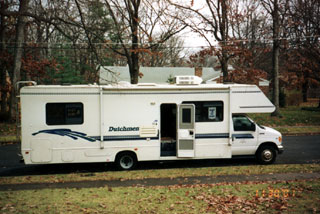

2001The 2001 Army-Navy Classic saw a reduced show of force from TRUCKRON ONE, as several of her personnel and the GONAVY were forward deployed in support of Operation Enduring Freedom. The seventh generation BEATARMY was left to face the Army onslaught alone, and it was perhaps because of this that the Navy team was overwhelmed on the playing field. Unfortunately, Navy's travails didn't end with the final gun, for on the voyage home to Virginia the BEATARMY's left rear wheel lost six of eight lug nuts on the New Jersey turnpike. The skipper's nerves of steel and Top Gun-esque piloting skills kept the vehicle from becoming a by-line on the evening news, but the crew's damage control efforts proved fruitless -- and at 2100 hours on December 2nd they abandoned ship, making this the first time in U.S. Navy history that an urban assault vehicle was lost in combat. Sabotage by Al Qaeda operatives was immediately suspected, but in a bizarre turn of events the Naval Criminal Investigative Service brought charges of treason against BEATARMY's own personnel. Subsequent courts martial cleared the crew of all wrongdoing. Commanding
Officer: Andrew D. Bush * * * * * * * * * |
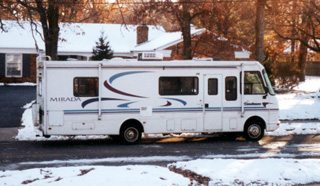
2002For the 2002 campaign, the Navy awarded a one-ship build contract to the Annapolis RV yard in Annapolis, MD. This raised more than a few eyebrows on Capitol Hill, since this was the very yard whose slipshod repair work resulted in the catastrophic loss of the BEATARMY only the year before. The Navy's trust proved well placed, however, as the eighth generation BEATARMY logged over 700 trouble-free miles through severe winter weather in support of Navy's record-setting victory. Commanding
Officer: Andrew D. Bush * * * * * * * * * |
